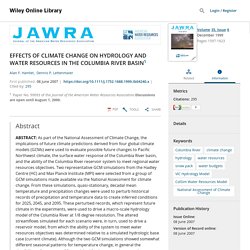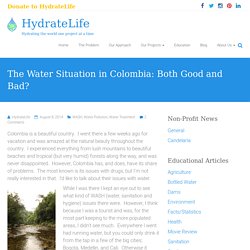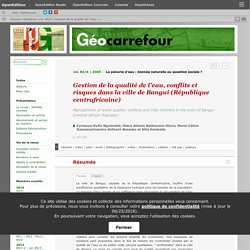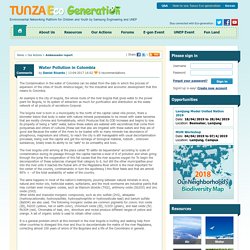

Les dauphins de la Manche contaminés par les perturbateurs endocriniens et le mercure. Plus d'une trentaine d'années après leur interdiction en Europe, on trouve encore des PCB dans la graisse des dauphins qui vivent dans la mer de la Manche.

Une étude publiée dans la revue Scientific Reports vient confirmer des résultats publiés en 2016. Une équipe de scientifiques belges et français a réalisé des prélèvements sur 82 des 400 grands dauphins vivant dans le golfe normano-breton, entre la pointe du Cotentin et Saint-Malo. Les résultats montrent des taux très élevés de perturbateurs endocriniens dans la graisse des cétacés. Jusque dans les années 1980, ces perturbateurs se trouvaient dans les vernis ou les encres d'imprimerie. Du mercure a également été détecté dans la peau des spécimens analysés.
Harmful algal bloom emerges in Colombian coastline.
EFFECTS OF CLIMATE CHANGE ON HYDROLOGY AND WATER RESOURCES IN THE COLUMBIA RIVER BASIN1 - Hamlet - 1999 - JAWRA Journal of the American Water Resources Association. ABSTRACT: As part of the National Assessment of Climate Change, the implications of future climate predictions derived from four global climate models (GCMs) were used to evaluate possible future changes to Pacific Northwest climate, the surface water response of the Columbia River basin, and the ability of the Columbia River reservoir system to meet regional water resources objectives.

Two representative GCM simulations from the Hadley Centre (HC) and Max Planck Institute (MPI) were selected from a group of GCM simulations made available via the National Assessment for climate change. From these simulations, quasi‐stationary, decadal mean temperature and precipitation changes were used to perturb historical records of precipitation and temperature data to create inferred conditions for 2025, 2045, and 2095. These perturbed records, which represent future climate in the experiments, were used to drive a macro‐scale hydrology model of the Columbia River at 1/8 degree resolution. El Niño in a changing climate. El Nino may cut Colombia's rainfall by 80 percent in quarter-one 2019: minister. The Water Situation in Colombia: Both Good and Bad? – HydrateLife. Colombia is a beautiful country.

I went there a few weeks ago for vacation and was amazed at the natural beauty throughout the country. I experienced everything from lush mountains to beautiful beaches and tropical (but very humid) forests along the way, and was never disappointed. However, Colombia has, and does, have its share of problems. The most known is its issues with drugs, but I’m not really interested in that. I’d like to talk about their issues with water. While I was there I kept an eye out to see what kind of WASH (water, sanitation and hygiene) issues there were. Suspecting that my experience may not be representative of how most Colombians live I came home and started reading about water and sanitation coverage there. Colombia has a population of a little over 48 million. These statistics come via the WHO/UNICEF Joint Monitoring Program, and are current as of April of 2014.
Moving on to the rural population, the numbers aren’t as good. That’s all for now. Sources. Water supply and sanitation in Colombia. Water supply and sanitation in Colombia has been improved in many ways over the past decades.

Between 1990 and 2010, access to improved sanitation increased from 67% to 82%, but access to improved water source's increased only slightly from 89% to 94%.[1] In particular, coverage in rural areas lags behind. Furthermore, despite improvements, the quality of water and sanitation services remains inadequate. For example, only 73% of those receiving public services receive water of potable quality[9] and in 2006 only 25% of the wastewater generated in the country underwent any kind of treatment.[6] Overview[edit] Responsibilities in the sector are divided as follows: Cost recovery in the sector has improved substantially.
Access[edit] Gestion de la qualité de l'eau, conflits et risques dans la ville de Bangui (République centrafricaine) 1Bangui, Capitale de la République centrafricaine (fig. 1), est localisée dans un espace où il pleut neuf mois dans l’année1.

Ainsi, y parler de pénurie d’eau semble anormal, du fait de la variété des ressources en eau (pluies, cours d’eau, marais et nappes aquifères). Néanmoins, la pénurie d’eau est caractérisée ici par la question de l’eau souillée dont l’utilisation constitue une entrave à l’émergence économique de la société. Controlling water pollution in developin20160630 32307 16r9jgj. IWRMinColombiaexpanded. Water Pollution in Colombia - Ambassador report - Our Actions - Tunza Eco Generation.
The Contamination in the water of Colombia can be dated from the date in which the process of expansion of the cities of South America began, for the industrial and economic development that this means to Colombia.

An example is the city of bogota, the whole route of the river bogota that gives water to the power plant for Bogota, to its system of extraction as much for purification and distribution as the waste network of all products of excretions Corporal. The same happens in most of the nation's metrolpolis, pouring between natural minerals in ecce, natural and motor oils, herbicidal waters, surfactants, and the most worrisome are industrial paints that may contain even inorganic oxides, such as titanium dioxide (TiO2), antimony oxide (Sb2O3) and zinc oxide (ZnO).
Other white and insoluble inorganic compounds, such as zinc sulfide (ZnS), albayalde (hydroxycarbonate, hydroxysulfate, hydroxyphosphite or hydroxysilicate lead) and barium sulfate (BaSO4) are also used.